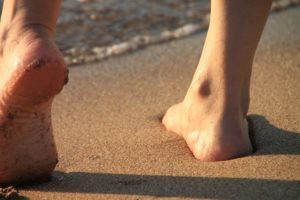
Why Is Your Achilles Tendon So Important?
It’s the most commonly injured and ruptured tendon in the body.
It’s the largest and strongest tendon in your body.
It’s important for walking, dancing, running, jumping, lunging, squatting, etc.

 The rate of achilles injuries continues to go up every year. This is likely due to an increasingly more active population around the world, along with improved data collection. The most common types of injuries to the achilles are tendinosis and rupture. The former is a degeneration of the tendon and the latter is a tearing of the tendon.
The rate of achilles injuries continues to go up every year. This is likely due to an increasingly more active population around the world, along with improved data collection. The most common types of injuries to the achilles are tendinosis and rupture. The former is a degeneration of the tendon and the latter is a tearing of the tendon.
Achilles injuries are linked to increased activity. Athletes account for about 2/3rd of achilles injuries, supporting the theory that achilles injuries are largely an overuse injury. However, about 1/3rd of achilles pain and injuries occur in people who are not physically active, which means that there’s also a metabolic component (impaired healing and recovery).
Why Does it Occur?
The two most common types of achilles tendon pain and injury are:
- Achilles Tendinopathy
- Achilles tendinitis
- Achilles tendinosis
- Achilles Rupture
- A tear of the achilles at its insertion on the heel bone (aka insertional rupture)
- More commonly in the 2-6cm up from the heel bone (aka non-insertional rupture)
It’s proposed that these injuries occur because of the following cycle:
Continuously overloading the tendon through activity → Microscopic tearing → Poor healing in the presence of continued overloading → Achilles tendon degeneration (which weakens the tendon) → Chronic achilles tendinopathy → Tendon remains weak chronic and degenerated without intervention → In this weakened state, the tendon is more susceptible to tear and rupture via mechanical stress (e.g. jumping, running, squatting, etc.)
Note: In some cases a rupture can occur just from the mechanical stress (e.g. landing from a jump) without the presence of the above degenerative cycle. However, the vast majority occur with some level of degeneration of the tendon, already present.
Signs and Symptoms of Developing Achilles Tendon Injury
- Morning pain and stiffness of the achilles tendon and/or calf
- Pain during the first few minutes of exercise
- Point tenderness along the achilles tendon when pinching your with your thumb and index finger, especially after exercise
- Visual enlargement or swelling of the tendon
- Take this quiz to and track your own symptoms: Achilles Tendon Quiz

Risk Factors
- Participating in sports or workouts that require a lot of running, jumping, pivoting, cutting, lunging, and squatting. Examples include:
- Running sports – track and field athletes, endurance runner (half-marathoner, marathoner, triathlete)
- Soccer
- Basketball
- Gymnastics
- Dance
- Not warming up before activity
- Flat feet or overly rigid arches: find out your foot type here
- Overpronation or oversupination: Causes a “wringing” effect of the achilles tendon and the tendon will often bow in or bow out when you’re standing (see image below on the left)
Note: this can often be corrected with a custom orthotic support and proper footwear.
Other risk factors include:
- Age – the risk of rupture increases with age
- Use of broad spectrum antibiotics (quinolones)
- Use of corticosteroids
- Systemic disease such as diabetes, gout, hypertension, and inflammatory arthritis
- Obesity
If you’re having signs and symptoms of achilles tendon injury, we’re here to help! Let us help you overcome your pain and live an active healthy lifestyle, today. (561) 318-8070
Albers, Duane, and Brian R. Hoke. “Techniques in Achilles Tendon Rehabilitation.” Techniques in Foot & Ankle Surgery 2.3 (2003): 208-19. Web.
Egger, Anthony C., and Mark J. Berkowitz. “Achilles tendon injuries.” Current Reviews in Musculoskeletal Medicine 10.1 (2017): 72-80. Web.
Saxena, Amol, Brynn Ewen, and Nicola Maffulli. “Rehabilitation of the Operated Achilles Tendon: Parameters for Predicting Return to Activity.” The Journal of Foot and Ankle Surgery 50.1 (2011): 37-40. Web.
©CenterForMusculoskeletalFunction2017





